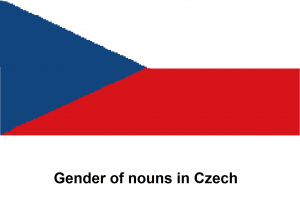Difference between revisions of "Language/Czech/Grammar/Gender-of-nouns"
Jump to navigation
Jump to search
m (Quick edit) |
m (Quick edit) |
||
| Line 1: | Line 1: | ||
[[File:Gender of nouns in Czech.png|alt=Gender of nouns in Czech|thumb|Gender of nouns in Czech]] | [[File:Gender of nouns in Czech.png|alt=Gender of nouns in Czech|thumb|Gender of nouns in Czech]] | ||
Hello Everyone, 😊 | Hello Everyone, 😊 | ||
| Line 8: | Line 7: | ||
Please feel free to edit this page if you think it can be improved! | Please feel free to edit this page if you think it can be improved! | ||
Happy learning! | |||
<span link>Consider exploring these related pages after completing this lesson:</span> [[Language/Czech/Grammar/Possessive-Case-in-Czech|Possessive Case in Czech]], [[Language/Czech/Grammar/Instrumental-Case-in-Czech|Instrumental Case in Czech]], [[Language/Czech/Grammar/How-to-Use-Be|How to Use Be]] & [[Language/Czech/Grammar/How-to-Use-"Být"-(to-Be)|How to Use "Být" (to Be)]]. | |||
__TOC__ | __TOC__ | ||
| Line 30: | Line 30: | ||
<youtube>https://www.youtube.com/watch?v=WFf-WhcezoE</youtube> | <youtube>https://www.youtube.com/watch?v=WFf-WhcezoE</youtube> | ||
== | ==Other Lessons== | ||
* [[Language/Czech/Grammar/Comaratives-and-Superlatives|Comaratives and Superlatives]] | * [[Language/Czech/Grammar/Comaratives-and-Superlatives|Comaratives and Superlatives]] | ||
* [[Language/Czech/Grammar/Negation|Negation]] | * [[Language/Czech/Grammar/Negation|Negation]] | ||
| Line 41: | Line 41: | ||
* [[Language/Czech/Grammar/Plural|Plural]] | * [[Language/Czech/Grammar/Plural|Plural]] | ||
* [[Language/Czech/Grammar/Adjectives|Adjectives]] | * [[Language/Czech/Grammar/Adjectives|Adjectives]] | ||
<span links></span> | |||
Latest revision as of 13:07, 27 March 2023
Hello Everyone, 😊
In today’s lesson we are going to study the following topic: ”GENDER OF NOUNS” in Czech
Please feel free to edit this page if you think it can be improved!
Happy learning!
Consider exploring these related pages after completing this lesson: Possessive Case in Czech, Instrumental Case in Czech, How to Use Be & How to Use "Být" (to Be).
A pretty reliable rule of thumb for determining the gender of nouns other than human masculine animates, is as follows:
Masculine in Czech[edit | edit source]
- Most nouns ending in a consonant, e.g. hrad ‘castle’, kufr ‘suitcase’, vlak ‘train’, stroj ‘machine’, čaj ‘tea’ [Some ending in a ‘soft’ or ‘ambivalent’ consonant are feminine, e.g. píseň ‘song’, tramvaj ‘tram’
Feminine in Czech[edit | edit source]
- Most nouns ending in -a, -e or the suffix -ost meaning ‘-ness’, e.g. voda ‘water’, lekce ‘lesson’, radost ‘joy, happiness’ [A few ending in -e are neuter, e.g. moře ‘sea’, pole ‘field’
Neuter in Czech[edit | edit source]
- Most nouns ending in -o or -í, e.g. město ‘town’, auto ‘car’, stavení ‘building’, náměstí ‘square’
Source[edit | edit source]
http://utkl.ff.cuni.cz/~rosen/public/GGG/Czech_essent_grammar.pdf
Videos[edit | edit source]
Learn Czech Grammar - Grammatical gender - YouTube[edit | edit source]
Other Lessons[edit | edit source]
- Comaratives and Superlatives
- Negation
- How to use the Modal Verb (Can)
- Future Tense
- Pronouns
- Questions
- Indefinite articles in Czech
- Inclusive Case in Czech
- Plural
- Adjectives
